

You are here
Moog voyager old school.
- Synthesizers
The Voyager Old School sees Moog returning to their roots, but is there a place for an all–analogue, 1970s–style synth in the 21st century?

In 2001, rumours began to circulate of a revised, regenerated Minimoog, followed by a competition to name Bob Moog's latest progeny. The resulting Minimoog Voyager answered the prayers of many. It was, after all, a monophonic analogue synthesizer from Moog featuring Moog oscillators, Moog filters, wood, MIDI, a responsive keyboard, patch memories and knobs and components that were shiny and new. Throw in patch points for extra control, a dedicated LFO, oscillator sync and waveform modulation and you'd think all the boxes had been ticked. However, some amongst the analogue community worked themselves into a lather, convinced that grafting menus onto a Mini was tantamount to nailing a humbucker pickup to a Stradivarius. Some saw it as cheating to dial up a patch from memory rather than making your own, on the spot, every time. Not even Bob Moog, it seemed, could please everyone.
Well, the beardy types' wailing and gnashing of teeth can cease, because there's another new Moog in town — one that rejects all things digital. Ladies and gentlemen, let me present the Moog Voyager Old School!

As the two synths are so intimately related, I'd advise you to revisit Gordon Reid's comprehensive review of the Voyager from June 2003's SOS. Here, like some twisted dentist, I'll ponder the impact of the extractions — and will doubtless wallow in nostalgia along the way. After all, merely glancing at the Old School takes me back to my youth — to a time when what you saw really was what you got. This Moog is that rarest of creatures: a modern synthesizer built with ergonomics, layout and style in mind. This is no exercise in feature cramming!
Weighing in at a hefty 18kg, the Old School is a serious contender. If you admired the standard Voyager, I think you'll agree its latest sibling wins any posing contest between them — without even needing to pout. The wood finish is superb, the feel of the knobs top–notch, and the 44–key (F to C) keyboard is a delight — it certainly beats any vintage Model D I've played for both speed and responsiveness.
On first power–up, the solitary pulsing LED of the Low Frequency Oscillator is understated in comparison to the extravagant light-shows of other Voyager models. This reserved façade blends more naturally amongst older synthesizers, and the lack of a backlit panel or glowing mod wheel should banish any fears of extraneous electrical noise.
No Minimoog would look right without its familiar tilting panel. This one offers five operating positions, although (as Gordon observed in his original review), the wooden case is too close to the rear jack sockets to allow you to use them when the panel is laid flat. Looking closely, you'll see that the panel is actually a printed laminate affair similar to those seen on Dave Smith's recent instruments — all very clear and logical. Scanning from left to right, we find the modulation section, consisting of an LFO and two modulation busses. Then the three VCOs, mixer, dual filters, envelopes and, finally, a big, friendly volume knob. Being both right–handed and a compulsive tweaker, I'd love to encounter a panel laid out in exactly the opposite direction, since the filter and envelope knobs seem to be where my left hand travels most often. Fortunately, the angled panel negates any crossed–arm obstructions!
Adjacent to every control is a pale–blue mark. This is your designated safe escape route, presumably for when it all goes horribly wrong. Once upon a time we patiently learned to program our synthesizers with patch–book examples and cardboard overlays. Frankly, Moog are the last company I'd have expected to print a 'default' patch on one of its synths — an indelible set of 'L' plates!
Mildly exasperated, I turned to the rear (or upper) panel, which is largely the same as the Voyager's. This means lots of quarter–inch voltage inputs (11 in total) for interfacing with expression pedals, or modular gear such as Moog's own Moogerfoogers. An effects loop insert point is provided too, ideal for plumbing in external effects after the mixer section and before the filters. This is one of those simple additions that prove to be genuinely worthwhile in practice and had me digging out a wide collection of old effects processors. Adjacent to the insert point, the external audio input is on hand to process any source you fancy — including the Old School's own headphone output. This version of the Minimoog trick sounds a trifle different in this incarnation; indeed, with the levels cranked up it threw up some of the most extreme (and occasionally scary) noises in the Old School's repertoire.
Cape Capers

Familiarisation with the controls took literally seconds, after which I started to get the kind of buzz that took me back to my earliest days discovering synths. The first area I turned to was modulation — perhaps the most significant upgrade from Minimoog architecture. This consists of two identical modulation busses, each offering six modulation sources routable to six destinations via any of a list of six controllers. I thought this synth was a beast, but I didn't realise it was The Beast! The sources available differ from those of a standard Voyager; they include the three VCOs, the LFO, the noise generator and an external modulation input. These may be routed to overall pitch, the pitch of Oscillator 2 or 3, filter cutoff, oscillator wave or LFO rate.
Wave modulation is something you couldn't do at all on a Minimoog, and the only drawback here is that it affects all oscillators — or none; you can't specify a single VCO wave to be modulated. If this isn't as flexible as you might like, it does at least keep things simple. The controller component of the modulation bus has the usual suspects: mod wheel, velocity, aftertouch and both envelopes, plus an external CV or expression pedal.
Lacking the menu options of the standard Voyager, the Old School benefits from more modulation controllers on its panel. But as there are only two busses and three main performance controllers, you might not be able to do everything you want in a single patch. For example, if you route velocity to the filter cutoff and aftertouch to wave modulation, you can't then bring the mod wheel into play — the two busses are already fully booked. Here's where that optional VX351 CV Expander (see 'CV Concerns' box) starts to look anything but.
LFOs & VCOs
I'm sure we all agree that a dedicated LFO is a vital thing to have. This one has a base range of approximately 0.2Hz up to 50Hz, but can be extended considerably by means of a positive or negative voltage at its CV input. There are just four waveforms available: triangle, square, sample-and-hold and smoothed sample-and-hold. Oddly there's no sawtooth — but sawtooth hunters will be pleased to know that, as per the Minimoog, you can draft in one of the three main oscillators for additional low–frequency duty. There's even a switch to deactivate it from the keyboard too, just like old times.
In stark contrast to my own (now departed) Mini, the VCOs behaved impeccably, stabilising after just a few minutes and staying that way. Oscillator 1's pitch is set by the main fine–tune control, with the other two oscillators detunable over a range of seven semitones, up or down. The oscillators sound great — from their lowest 32' setting right up to 1', an octave that comes into its own when you start to explore another 'post Model D' trick — Frequency Modulation. At the flick of a switch, VCO3 becomes the FM source for VCO1, serving up wild excesses of discordant metallic tones, adding bite to any solo.
Speaking of bite, I was recently impressed by Moog's Freqbox and its rich oscillator sync, and I'm even happier with the Old School's implementation. Draft in a modulation bus giving aftertouch control over Oscillator 2's frequency, and you're in sync heaven. I'm guessing Moog improved the aftertouch response after the original review, because I found it played very well, second only to Korg's Prophecy in my own 'pressure hit parade'.
Filters & Envelopes
The original Minimoog's single low–pass filter was enough to make it legendary. The Old School has two of them and a switch that determines which configuration you want: parallel low–pass mode or serial high– and low–pass. Choose parallel and each filter is routed to a separate audio output; choose serial and audio is sent equally to both.
As has been said before, Moog don't provide a way to access each filter's cutoff frequency individually. Instead, a spacing control sets the interval between them over a range of +/– three octaves. Switch into High–pass/Low–pass mode and you enter thin and raspy territory; if you're looking to break away from blatant Moog power, this could become a favourite, with filter spacing acting as a direct thin/fat control.
The ADSR envelopes are positioned vertically and offer a snappy response rated between one millisecond and 10 seconds. I wasn't particularly taken by the way the knobs are calibrated. In the case of attack, the bulk of the knob's travel is occupied by the fastest attacks, and in the case of release, a large portion of the knob's movement translates to very short release times; only the last sliver of pie is available to set a range between one second and maximum. On the review model, this maximum was over 20 seconds, so finding accurate release times proved rather finicky. It's likely that my solos are just too slow and 'new agey', but this is something to be aware of when you audition an Old School.
As with the Minimoog, the envelopes default to single triggering. This suits my noodly style perfectly — but could be troublesome if you need fast, articulated phrasing. In such cases, multi triggering is available, but is activated by powering on while holding down the top two keys of the keyboard. Not something you'd want to do live! You must also do this every time multi–triggering is needed, as the status is not remembered. The keyboard employs last–note priority rather than the Minimoog's low–note bias, which I think is an improvement. Lastly, a switch will deactivate keyboard triggering of the envelopes — handy when processing external signals via the filters.
If, before the release of the first Voyager, you had asked me what I would hope to find in a modern Minimoog, it wouldn't have been a hundred miles from the Voyager OS. Its full title, 'Minimoog Voyager Old School', is a bit of a mouthful, though; how nice it would have been to simply say Minimoog Model E! This synth is just as comfortable in a lead performance role as the Model D was all those years ago. One look at the panel and you know exactly where you are; its controls feel just right and they're ergonomically spaced for unimpeded access to a wealth of Moog tones. You're not stuck in the past, though: the Old School has way more to offer, thanks to a dedicated LFO, oscillator sync, FM and the dual filter arrangement. Factor in the twin modulation bus and rear–panel interfacing and the options seem to grow exponentially.
There are 896 patches in a V3 Voyager, but I warrant a skilled Old School performer should be able to rustle up the sound he or she wants in the time it takes to locate a favourite amongst that lot — with the advantage that each time it will be a little different. Don't go for an Old School if you insist on absolute repeatability in your music; without memories to draw from, the synthesizer player is forced not to memorise (or write down) each favourite patch but to understand the instrument so deeply that it becomes intuitive. At £500 less than a Voyager Performer, the Old School could be both a money saver and an education.
Not everything in the garden is rosy, however. Dropping MIDI seems a cut too many when faced with the challenge of sequencing the Old School via the CV input. A lesser gripe is the difficulty of setting long attack and release times accurately. Admittedly, this could be more about my preference for a particular style of flowing solo than a serious complaint. Actually, if I had to name just one thing that genuinely bugged me, it's those 'default' patch markings. They really spoil an otherwise elegant panel. Yes, I'm a grumpy old man to get fixated on such things — but have we really dumbed down so much in the space of 30 years that this is necessary?
To sum up, the Voyager's digital bits were never part of its signal path anyway, but if you feel that this new–fangled MIDI lark and patch memories are cheating, or if you simply dream of a modern, reliable, simple–to–use Moog, the Voyager Old School is exactly what the doctor ordered.
Alternatives
Genuine alternatives to the Voyager Old School are thin on the ground, not least because monophonic analogue synthesizers (with or without MIDI) aren't exactly hurtling off production lines. If we peer into the future a little, the forthcoming MacBeth X–Factor promises to be a serious contender, and the Analogue Solutions Leipzig also looks interesting. But for the time being, it's probably another US company that offers Moog the most serious challenge — in the form of the Prophet 08 from Dave Smith. This eight–note polyphonic analogue has MIDI, knobs, a sequencer, patch memories and much more. Admittedly, the endless rotaries don't offer the same instant visual feedback as an Old School and modulation is set via menus, but Dave Smith packs a lot into a compact, affordable synth. Or, for much less cash, Dave's Mono Evolver keyboard with its mixture of digital and analogue technology can't be ignored.
If you turn to digital, the Access Virus TI series still sounds fabulous to these old ears although, granted, there's a little menu–hopping to do. Clavia's Nord Wave fares better in that respect, but its mono mode doesn't handle like a true analogue. Like many digital synths since the Korg Prophecy, its envelopes restart at zero on each keypress, reducing my flowery synth solos to something more like an accordion or melodica! Thankfully, the Virus gets that bit right — something to note if you share my fondness for a certain Schulzian Moog style.
CV Concerns...
Despite the Old School's diverse connectivity, a few desirable features failed to earn a place amongst the throng. There's a dearth of voltage outputs, although, as an optional extra, these can be added courtesy of Moog's VX351 CV Expander. This hooks up via a small multi–pin connector and provides access to voltages produced by the keyboard's velocity and aftertouch, as well as the mod wheel, and more. Be aware that this expander was created for the original Voyager, so some of its outputs (for example, that of the Touch Surface) don't apply to the Old School or, in the case of the keyboard pitch and gate outputs, duplicate what is there already.
It's fortunate that CV and Gate interfacing are on board, since, with MIDI cast aside, the Old School needs some way to interact with the outside world. In my own tests I found that the keyboard's output voltage was scaled much lower than that of my Roland SH101. Oddly, all notes below the keyboard's bottom C sent the Roland into a spin — although three octaves (C–C) worked reliably. Investigation revealed that the Old School puts out negative voltages for any notes below the lowest C, which some synths (such as the 101) can't cope with.
Unfortunately, it was the incoming pitch–CV response that caused me real problems. Driven by the SH101 or by my Kenton Pro 2000 MIDI–to–CV converter, the Old School did not track accurately at all. Moog inform me they decided to omit CV input calibration from the design, and I am advised that the best solution is to use an attenuator from either a VX351 or a Moogerfooger CP251 Control Processor (or a similar module, if you have a modular synth) to tweak the incoming voltage until the Old School plays in tune.
Personally, I can live without patch memories and MIDI control of knobs — but without basic MIDI note reception, I can't drive those chuggy Moog basses from a sequencer without added cost or complication. At this point my nostalgia transferred briefly to the dawn of MIDI: the solution to exactly this kind of voltage incompatibility.
Off The Menu
Obviously, there are tricks a digitally–empowered Voyager can do that are beyond the remit of the Old School — without a menu system, much has to be simplified. Thus, the Old School has no way to transpose the keyboard or set different velocity curves. The pitch–bend range is preset at the factory via an internal jumper, and so is not programmable per patch. The review model was set at seven semitones up or down, but you can change it (from +/– two semitones up to +/– one octave) by following instructions provided on Moog's web site.
There's no equivalent of the Voyager's menu–based mod wheel and pedal destinations (or pot mapping), but it was another of the Voyager's hidden aces that I missed the most: other Voyagers let you freely select the number of poles used by each filter, from one, two, three or four. Both the Old School's filters are fixed at four poles, the Moog standard.
- Fabulous Moog sounds.
- Handles like a dream .
- Stunning good looks.
- MIDI is gone and the pitch CV input doesn't guarantee accurate tuning without external hardware attenuation.
- Those 'default' patch markings! Do you really want someone else's idea of a default patch forever etched into your pride and joy?
Priced between the Little Phatty and the various Voyager models, the Old School represents Moog's purest successor to the fabled Model D. Its WYSIWYG approach is direct and intuitive, and the synth is a pleasure to play. Although not designed to exactly emulate a Minimoog, it has Moog oscillators, envelopes and filters, so can cover the same ground and much more.
information
Arbiter +44 (0)20 8207 7880.
www.arbiter.co.uk
www.moogmusic.com
Moog +1 828 251 0090.
New forum posts
- Re: Harpsichord David Glover > 15 May 2024, 00:35 Music Theory, Songwriting & Composition
- Re: Is this what will literally completely devalue song-writing, engineering, mixing, mastering? alexis > 15 May 2024, 00:18 Music Theory, Songwriting & Composition
- Re: ksoloti Gills standalone BJG145 > 14 May 2024, 23:54 DIY Electronics & Studio Design
- Re: Is this what will literally completely devalue song-writing, engineering, mixing, mastering? BJG145 > 14 May 2024, 23:34 Music Theory, Songwriting & Composition
- Re: PolyBrute 12 Eddy Deegan > 14 May 2024, 23:30 Keyboards & Synthesis
Active topics
- ksoloti Gills standalone
- New Loops Releases "Hip-Hop and Trap Lofi Drums Vol.1 & Vol.2" with 25% off Intro Offer!
- PolyBrute 12
- Rescopic Sound Releases Cosmic Transitions Free SFX Library
- Voltage Lab 2 from Pittsburgh Modular
- VSTBuzz: 40% off “Delicata” by ASTS Sound Design
- Universal Audio expand Standard Series
- Harpsichord
- Windows tablet & backing track
- Melda PowerStrings
Recently active forums
- Recording: Gear & Techniques
- Mixing, Mastering & Post Production
- New Products & Industry News
- Music Business
- Windows Music
- Apps & Other Computers/OS
- Guitar Technology
- Keyboards & Synthesis
- DIY Electronics & Studio Design
- Live Sound & Performance
- Music Theory, Songwriting & Composition
- User Reviews
- Remote Collaboration
- Self-Promotion
Create an account
- Manufacturers
Moog Minimoog Voyager
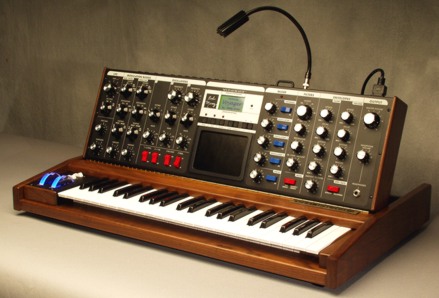
Description
The Moog Minimoog Voyager is an analog synthesizer designed by Moog Music. It is a modern version of the classic Minimoog Model D synthesizer, which was released in 1970. It has been used by a variety of artists, including Herbie Hancock, Kraftwerk, and Daft Punk.
The Minimoog Voyager works by generating sound waves using three voltage-controlled oscillators. These oscillators can be used to create a variety of sounds, from bass and lead lines to pads and sound effects. The Voyager also features a low-pass filter, envelope generator, and a variety of modulation sources. It also has a built-in arpeggiator and sequencer, allowing users to create complex patterns and sequences. Additionally, the Voyager has a variety of effects, including delay, chorus, and reverb.
Product Information
More products by moog music.
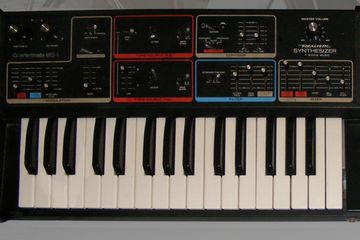
More products
- My former gear
- My current gear
- My wishlist

Moog Music Minimoog Voyager
Analog Synth from Moog Music belonging to the Minimoog Voyager série series
Minimoog Voyager classified ad

End of the road for the Minimoog Voyager

Limited Edition Moog Synths in White

Voyager OS Update

Tech. sheet
- Manufacturer: Moog Music
- Model: Minimoog Voyager
- Series: Minimoog Voyager série
- Category: Analog Synths
- Added in our database on: 04/08/2004
We have no technical specifications for this product but your help will be much welcomed
Fill in the product description
Cancel Save
Manuals and other files
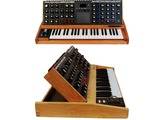
Other Moog Music analog Synths

Analog Synth
Other categories in synthesizers/racks/modules.

Other names: minimoog voyager, minimoogvoyager, minimoogvoyager

- Try For Free
Synth Tutorial: FM on the Minimoog Voyager
In this synth tutorial, watch Joe Hanley, the creator of Syntorial, as he demonstrates how to use FM on the Minimoog Voyager . This video is an excerpt from the Minimoog Voyager Lesson Pack for Syntorial, which contains 34 videos, totaling 2 hours and 22 minutes, and covers every inch of this analog classic.
VIDEO TRANSCRIPT In this video, I’ll be showing you how to use FM. Also known as frequency modulation on the Voyager. I’ll be going over how to make different bell tones as well as how to make an aggressive distorted tone.
Now, this following clip is an excerpt from the Minimoog Voyager lesson pack for Syntorial. Which has 34 videos, totaling two hours and 22 minutes, that go over every inch of the Voyager. And it’s free for all registered Syntorial users.
Now, for those who don’t know, Syntorial is video game like training software. That teaches you how to program synth patches by ear. It does this by combining video demonstrations with interactive challenges in which you program patches on a built-in soft synth. And the Minimoog Voyager lesson pack, adds 34 videos that show you how to take the things you’ve learned in Syntorial and do it on the Voyager.
I’ve made a special demo available for you guys to download. Includes 18 lessons and five Voyager videos by clicking the link that’s appearing on your screen now.
Now before we get started, you wanna initialize your synth. This will make programming a lot easier. And I recommend going to the webpage below and following these instructions right here in this box.
Now not only will show you how to use the Voyager’s built-in initialization function, but more importantly, it adds steps that will show you how to change the phase of the synth, so it matches what you hear. Because if you just use the initialization function, the inside of the synth turns into a very simple sound, but the phase of it doesn’t change obviously, which can be kinda confusing particularly for those of you who are a little newer to the Voyager or just newer to programming. So I recommend following these steps before you get started. Here we go.
Voyager FM. The FM is a little trickier to program on the Voyager, compared to Syntorial. The routing is fairly simple, oscillator three is our modulator, oscillator one is our carrier. So we wanna hear the carrier. We don’t wanna hear the modulator. So only oscillator one will be on. And then you simply just turn the FM switch on.
Now with Syntorial we’re doing sine waves. There are no sine waves in the waveform selection. We’ll do the next best thing. We’ll turn both to triangles. Now you’re not getting much yet. So we need to turn this frequency up and I like my favorite spot is around the sixth notch.
Start to hear some of that FM. You can get it in the other values, but it changes the overall pitch. This keeps, C sounding like C. Whatever note you’re playing, sounds like the note you’re playing.
Now I’m gonna increase our AMP release a little bit, just to give us a little bit more of a bell-like quality. Good.
Now, Oscillator three’s waveform knob, in this situation, it’s kinda like Syntorial’s FM knob. As you turn it up, you get a little bit brighter, go towards saw. You can go all way to about this notch here. Compare it to, little rounder. Little brighter. So it’s kinda like Syntorial’s FM knob. Go pass that, it starts to get dissonant.
Now, if I wanna change the overall range of my bells, I can turn both octaves up. And then we can take oscillator three’s octave and move it down. It gets a little dissonant but it’s a little bit more FM-ish. A little bit more metallic. Could even go down one further and it gets pretty aggressive. We’ll go back to four.
Now, one thing you might notice, is as I jumped from note to note, sometimes it takes a second for the pitch to kinda catch up. It kinda sound like… So it’s like the very beginning of your notes sounds sort of out of tune until it kinda comes together.
In some ways, this can be kind of cool, but if you don’t want it, what you can do a sort of mask it with a little bit of glide. So I’m turning the glide on. And now… now, if I’m intentionally bending between the notes, then you won’t really notice that accidental FM bend between the notes. So that’s how you can get your nice sort of bell like metallic tone with FM.
There’s another great use we can get from FM and the Voyager. And that’s really nice, aggressive, distorted tone. To do this, I’m gonna change oscillator one to square, oscillator three to about there a little bit above the saw, right at the saw graphic actually.
We’re gonna bring oscillator one back down to its regular octave, our default octave. And we’re going to bring octave three, one octave below that and then set its frequency back to zero. And here’s what it sounds like. Let’s turn glide off.
Really nice aggressive distorted sound. And you can adjust the wave. And I like it right around the saw. And you could bring oscillator three’s octave one lower to get even nastier. And then we can bring the frequency back up, if you want to add a little bit more of that metallic bellish-like quality to it. Really nice distorted tone.
Lastly, it’s really easy to come across a dissonant tone with FM. Set it to any random frequency, random wave forms, and you could come across as sometimes bizarre sound effects and dissonant sounds. So it’s a great way to create sort of experimental sound effects and things like that.
So your task is to create three new patches, one, a smooth bell tone like we did with the triangles, another, a nice heavy distorted tone. And then lastly, something just bizarre from a random setting of your choice.
All right, Well, thanks for watching. And just so you know, we’ve got a lot of other free videos like this available on Syntorial’s website. All you gotta do is sign up for our newsletter by clicking the link that’s popping up on your screen now, and we’ll send you a link to a page full of videos and articles.
Moog Minimoog Voyager

- 0 Keybed provides a unique, immersive playing experience
- 0 Rock-solid reliability and durability
- 0 True analog monophonic synthesizer with classic Moog sound
- 0 Extensive patching facilities and MIDI I/O for versatile connectivity
- 0 Three oscillators and dual filters for rich sound shaping
- 0 Onboard storage for 128 Program memories
- 0 Signature and Performer editions offer aesthetic and functional choices
- 0 Used by renowned artists across genres, adding to its prestige
- 0 Built-in touch surface for expressive control
- 0 Solid hardwood cabinet with hinged control panel for both aesthetics and functionality
- 0 Heavy and bulky, challenging for setups with multiple keyboards
- 0 Audio outputs must be unplugged to fold down the synth
- 0 Pulsing blue lights behind wheels can be distractingly bright
Note: These pros and cons have been generated using Equipboard's AI, which analyzes product reviews submitted by our members, as well as reviews from customers who purchased this product on third-party retailers. Help the community by upvoting pros and cons you agree with, and downvoting ones that are not accurate.
Description
Immerse yourself in the world of sound creation with the Moog Minimoog Voyager , a synthesizer that combines tradition and innovation. Drawing inspiration from the original Minimoog Model D of 1971, this instrument brings the same rich, analogue tone and adds a modern touch with its extensive customization options. The Voyager Select Series, launched in 2006, offers a variety of cabinet woods and backlight options, including Blue, Fire, Indigo, Jade, Lunar, or Solar. This model is a visual delight with a performance to match, identifiable by the 'Select Series' label above the display. Unleash your creativity with its 3 wide range voltage controlled oscillators , a noise source, 2 resonant filters, an external audio input, 2 ADSR envelopes, and an LFO, among other classic traits.
Key Features:
- Inspired by the original Minimoog Model D (1971)
- Part of the highly customizable Select Series (2006)
- Variety of cabinet woods and backlight options (Blue, Fire, Indigo, Jade, Lunar, Solar)
- 3 wide range voltage controlled oscillators
- One noise source
- Two resonant filters
- External audio input
- Two ADSR envelopes
- LFO among other classic traits
- 'Select Series' label for easy identification
Average Price: $3,500 High-end/Boutique
In the Synthesizers category, Moog Minimoog Voyager is priced in the High-end/Boutique range . This premium gear is built to very high standards and offers premium features.
2 AVAILABLE FROM
* Product prices and availability are updated by Equipboard every 24hrs and are subject to change. Equipboard may receive compensation for purchases made at participating retailers linked on this site. This compensation does not affect what products or prices are displayed, or the order of prices listed. Learn more here .
GENRE AFFINITY
194 Artists use this
Found 0 artists

John Frusciante

"His collection includes a Doepfer A100 modular synthesizer, a Mellotron, a Minimoog, and a 1970 ARP 2500. “For a long time I was using m... see details

Skrillex is seen twisting the knobs of a Mini Moog Voyager at 1:46. see details

I checked out this website and in the list of synths,there is a Moog Minimoog listed. It could be this Moog Minimoog Voyager. Guy Man al... see details

Calvin Harris
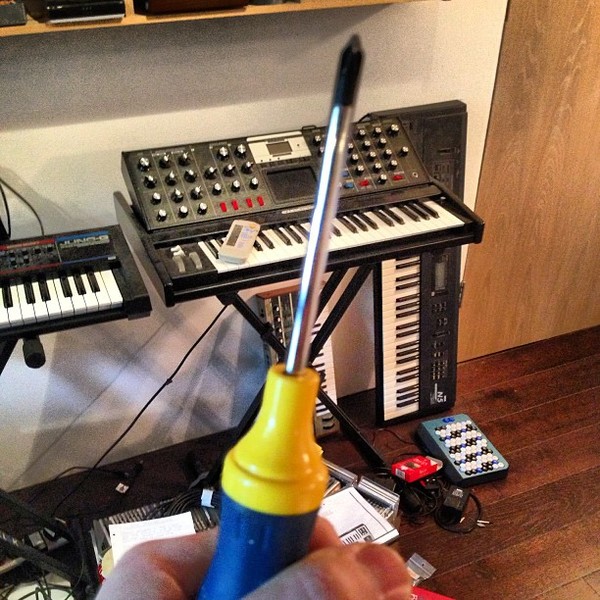
The Minimoog Voyager is one of the synths in Calvin Harris' studio, it can be seen in several photos and videos. see details

Matthew Bellamy
Mix engineer Tommaso Colliva on recording Drones : "There are fewer keyboards on Drones than on previous albums, and the ones we did use ... see details

From this website. see details
Trusted musician and artist reviews for Moog Minimoog Voyager
Based on 10 Reviews and 85 Ratings
The highly anticipated Minimoog Voyager synthesizer has arrived! This masterpiece of a synthesizer marks two landmarks in the history of synthesizers: the rebirth of the Minimoog and the return of Moog Music! Dr. Robert Moog himself helped design this modern-day Minimoog along with Big Briar. Big Briar (formed by Dr. Moog in 1978) became popular in the nineties with their Moogerfooger analog effect boxes and Etherwave Theremins. In 2002, Moog got the rights back to Moog Music so Big Briar (and all its products) are now Moog Music. Moog Music introduced the Minimoog Voyager synthesizer in two editions: the Signature Edition and the Performer Edition. There were only 600 Signature Edition models and they listed for $3,495 each! Their unique features include: Hand-finished wood cabinet in your choice of genuine solid maple (light), cherry (honey-colored), or walnut (brown), illuminated, clear acrylic Pitch Bend and Modulation wheels, gold-plated nameplate, padded Gig Bag, 4-year warranty with two free factory tunings, and is individually inspected and signed by Bob Moog. The Performer Edition listed for $2,995 and has a solid hardwood cabinet. The Minimoog Voyager is a true analog monophonic synthesizer (probably the most expensive one of its kind) and is based entirely on the original classic Minimoog Model D, which was produced by Moog Music, Inc. from 1970 to 1982. It introduces many new features, including a three dimensional touch pad, MIDI I/O, extensive patching facilities, patch storage, and more! It's cased in a beautiful, solid hardwood cabinet with a multi-position hinged control panel. Just like the original, the Voyager has three analog wide-range voltage controlled oscillators, one noise source, as well as one audio preamplifier for externally-applied audio signals. Two resonant Moog-style filters are on-board and function in dual lowpass or lowpass/highpass modes and can be modulated by one of the two ADSR envelopes, the LFO, or external control. All knobs and switches can have their settings stored into one of 128 Program memories. Program Banks as well as the Voyager's Operating System can be uploaded/downloaded via MIDI SysEx. Centered on its front panel is the ominous, black 3-D (XYZ) Touch Surface which provides three continuously-variable control signals which are derived from the up-down and left-right position of the player's finger, and the amount of area with which the player makes contact to the surface. There's also a 44-note keyboard, this time with velocity and aftertouch sensitivity. Also on-board are Pitch and Mod wheels, Glide/Portamento, and a series of 1/4" CV and/or Pedal jacks lining the top/rear of the front panel. The Mod Wheel can be sent to control all oscillators, or just VCO2, VCO3, the filter cutoff, or LFO rate. The Mod can gets its source from the LFO (triangle/square/sample-n-hold waveforms), VCO3, or the external Mod2 input. A Mixer Module gives you a five-input mixer for combining various audio sources prior to filtering between the oscillators, noise and external audio input signals. The new Minimoog Voyager is a first class synth; every bit as elegant in look as sound and quality. It is highly streamlined and offers all the functionality of a modern day (mono)synth with the classic, warm, unforgettable Moog sound. It WILL replace your original Minimoog (if you're lucky enough to have one). Signature models will become prized possessions for decades to come, and the Performer models will prove to be major players in future of music to come!! It's being used by Stevie Wonder, Maroon 5, the Crystal Method, Electric Skychurch, Duran Duran, Air, Morcheeba, Black Eyed peas, Nine Inch Nails, Blues Traveller, Red Hot Chili Peppers, Dido, The Cure, Herbie Hancock, Rick Wakeman, Yes, Nickelback, Dream Theater, Paul Simon, Joy Electric, the Neptunes, Alicia Keys, CeeLo Green, Madonna, Incubus, FUN, Radiohead, Bjork and more!
would you stop posting marketing propaganda as your reviews?
Best. Synth. Ever.
If you're reading this, you probably already know what it is and what it can do. So rather than review the features, I'll explain why I love it. I was classically trained on piano, and play mostly Jazz / Rock keys and electric guitar. I play with my hands. I step on stompboxes, work the wah, tweak knobs. I'm a knob tweaker. Scrolling through endless presets is not my style. With my Voyager, and all its glorious knobs, I feel like I am really connecting with the instrument not only on a tactile sense but a deeper, creative sense. I can physically adjust every setting by turning and flipping instead of scrolling or swiping, etc. The only thing that could possibly make this any better is if it were a polyphonic. But there are three oscillators, so creating intervals is easily done! And if you like presets, there are some great ones.
Never ceases to bring a smile
I love my minimoog voyager. It's the electric blue one. I find programming it relaxing, fun and entertaining all at the same time. It's well known that the minimoog can produce fabulous bass tones and lead tones but until you actually play them it's difficult to appreciate. This was a vanity purchase really, I've lusted after one since I first heard Lucky Man and Yes. I had to wait 40 years to be. Able to afford one but it's worth it.
$$$$$$$$$$$$$$$$$$$$$$$$$$$$$$$$$$$$$$$
this set me back way more than I would have liked but it is a great synth that I use more than most of my others, I think I need to stay away from moog products, I can't help myself...
The King of Analog Mono Synths
Incredible tone. Absolutely love this synth. The king of bass and vintage sounding leads. Built like a tank. What more can I say?
Bob Moog. Enough said.
From Gear Setup:

does not get any better than ever i think
This is cool. My only hardware-synth.
Low End, Low End
Another beautiful well build piece of equipment.
Very deep and awesome sounding mono synth.
6 Community Gear Photos
Torchandnail.


rettervondunkel
5 alternatives.

Moog Minimoog Voyager RME Rack Mount Edition
This is Moog's rack mount edition of the MiniMoog Voyager, for those who want the authentic Voyager sound in a more portable and space-efficient form factor.

Moog Minimoog Voyager Limited Edition "Select Series" Synthesizer

Moog Minimoog Voyager Lunar Gold Limited Edition

Moog Minimoog Voyager XL Synthesizer

Moog Minimoog Voyager Performer Edition
More synthesizers.
-m.jpg?v=1715689312)
Moog Grandmother

Moog Sub 37 Paraphonic Analog Synthesizer

Moog Subsequent 37

Moog Sub Phatty

Moog Matriarch

Moog One Polyphonic Analog Synthesizer
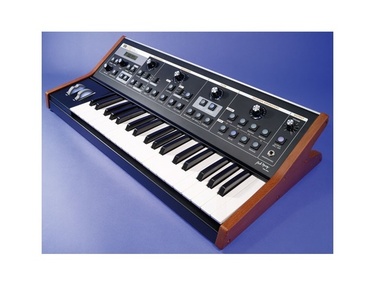
Moog Little Phatty

Moog Memorymoog

Moog Theremini

Moog Little Phatty Stage II

Moog (Realistic) Concertmate MG-1
Moog Subharmonicon

Moog Prodigy

Moog Subsequent 25

Moog Minimoog Voyager Electric Blue Edi...

Moog Grandmother Dark

Moog Micromoog

Moog Etherwave Standard

Moog Taurus 3 Bass Pedals

Moog Sirin Analog Synthesizer Module

Moog Source

Moog Polymoog Synthesizer

Moog Taurus I

Moog Matriarch (Dark Edition)

Moog Opus 3

Moog Etherwave Plus Theremin
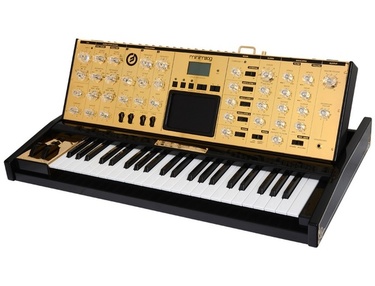
Moog Minimoog Voyager Lunar Gold Limite...

Moog Multimoog

Moog Sonic Six

Moog Minimoog Model D Reissue

Moog Liberation

Moog Little Phatty Tribute Edition

Moog Minimoog Voyager Limited Edition "...

Moog Minimoog Voyager RME Rack Mount Ed...

Moog Taurus II
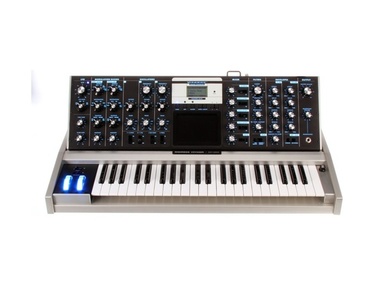
Moog Aluminium Minimoog Voyager
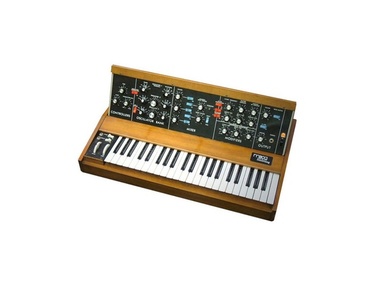
Moog Minimoog Model D
Members who saved this item.

COMMENTS
The Minimoog Voyager is a handcrafted, all-analog performance synthesizer. The Minimoog Voyager is a handcrafted, all-analog performance synthesizer that incorporates the features and incredible sonic range of the original Minimoog, while adding a vast number of new functional improvements to its design.
The Minimoog Voyager is a true analog monophonic synthesizer (probably the most expensive one of its kind) and is based entirely on the original classic Minimoog Model D, which was produced by Moog Music, Inc. from 1970 to 1982. It introduces many new features, including a three dimensional touch pad, MIDI I/O, extensive patching facilities ...
The Minimoog Voyager or Voyager is a monophonic analog synthesizer, designed by Robert Moog and released in 2002 by Moog Music.Five years earlier in 1997, the Minimoog Voyager Electric Blue was first produced by Moog Music. The Voyager was modeled after the classic Minimoog synthesizer that was popular in the 1970s, and is meant to be a successor to that instrument.
The Dedicated LFO. Bob Moog and the finished Voyager at its launch.Photo: Mark Ewing Unlike the Minimoog, the Voyager offers a dedicated LFO with a range of approximately 0.2Hz to 50Hz. This is no minor improvement; it frees VCO3 for audio duties, or allows you to use both the LFO and VCO3 as modulators.
Moog Minimoog Voyager XL. Analogue Synthesizer . Synthesizers; By Gordon Reid. ... turning the Voyager XL into a synth with touch‑sensitive brightness, loudness, vibrato and growl takes just seconds this way. The Voyager became a hugely better synth when Pot Mapping was introduced; it's only a shame (although an entirely understandable one ...
By Paul Nagle. Published December 2008. The Voyager Old School sees Moog returning to their roots, but is there a place for an all-analogue, 1970s-style synth in the 21st century? The classic iconic look.Photo: Mike Cameron At its inception, the Minimoog was surprisingly close to being the perfect solo synthesizer.
The Moog Minimoog Voyager is an analog synthesizer designed by Moog Music. It is a modern version of the classic Minimoog Model D synthesizer, which was released in 1970. It has been used by a variety of artists, including Herbie Hancock, Kraftwerk, and Daft Punk.
The Minimoog Voyager is an analog synthesizer with three octaves and a whole lot of knobs. It also has a pitch and modulation wheel and pretty standard inputs and outputs. The Voyager has all types of synth sounds from your traditional Moog lead synth and bass. These are just the beginning sounds as the tones that can be produced with this are ...
Historically, the Minimoog is considered the very first synthesizer for musicians! Compact, affordable, simplified and based on the megalithic modular Moog synths, the Minimoog became the most popular synth of all time, and still is to this day!Prior to the Minimoog, synthesizers were custom built to order, and required a great deal of technical knowledge to be able to wire up and create a sound.
Minimoog. The Minimoog is an analog synthesizer first manufactured by Moog Music between 1970 and 1981. Designed as a more affordable, portable version of the modular Moog synthesizer, it was the first synthesizer sold in retail stores. It was first popular with progressive rock and jazz musicians and found wide use in disco, pop, rock and ...
The Minimoog Voyager Old School differs from the other Voyager models with its traditional aesthetic. It features all analog controls and no display. Each Minimoog Voyager is inspired by the original Minimoog Model D released in 1971 and features 3 wide range voltage controlled oscillators, one noise source, 2 resonant filters, an external ...
In this synth tutorial, watch Joe Hanley, the creator of Syntorial, as he demonstrates how to use FM on the Minimoog Voyager. This video is an excerpt from the Minimoog Voyager Lesson Pack for Syntorial, which contains 34 videos, totaling 2 hours and 22 minutes, and covers every inch of this analog classic. VIDEO TRANSCRIPT. In this video, I ...
The Minimoog Voyager XL was released to celebrate the 40th anniversary of the Minimoog Model D. The Voyager XL builds on the original Voyager models but expands the keyboards to 61 keys and adds a ribbon controller, an additional LFO modulation bus, and a modular patch bay. Each Minimoog Voyager is inspired by the original Minimoog Model D ...
The Performer Edition listed for $2,995 and has a solid hardwood cabinet. The Minimoog Voyager is a true analog monophonic synthesizer (probably the most expensive one of its kind) and is based entirely on the original classic Minimoog Model D, which was produced by Moog Music, Inc. from 1970 to 1982.
Guitar Center's Product Spotlight showcases the Moog Voyager Synthesizer.Check it out at any Guitar Center or at http://www.guitarcenter.com/Moog-Minimoog-Vo...
The Electric Blue Edition of the Minimoog Voyager was based on the Anniversary Edition model released in 2004. It looks similar to the 50th Anniversary Edition but can be identified by the 'Electric Blue label above the display. Each Minimoog Voyager is inspired by the original Minimoog Model D released in 1971 and features 3 wide range ...
The Moog Minimoog Voyager RME, which stands for rackmount edition, serves up all of the power, versatility, and sound of the classic monophonic Voyager in a 5U 19 Rack format. The Voyager RME works well in virtually any setting, from professional studios to stage setups with a MIDI keyboard. Of course, the iconic triple-VCO voicing is featured ...